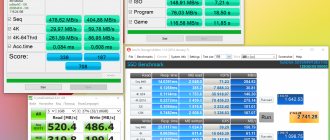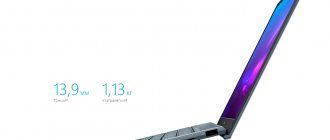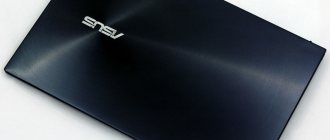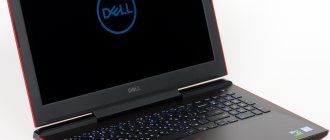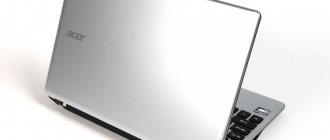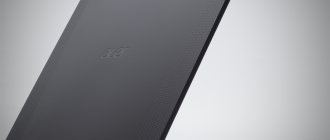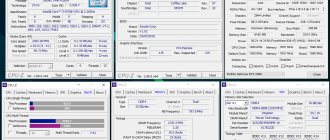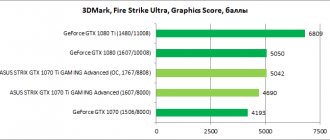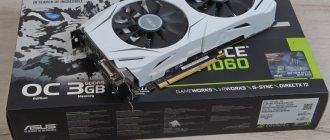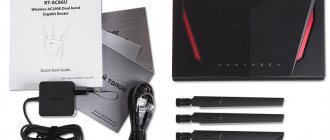Not long ago, a review of the ZenBook 14 UX433FN was published on our website. In my opinion, ASUS has produced a very decent ultrabook with a 14-inch screen. The trick of this device is that with such characteristics it turned out to be more compact than many other systems equipped with 13-inch displays. Well, similar impressions emerge when getting acquainted with the ZenBook 15 UX533FD. As I already said, here is the largest ultrabook that we have tested recently, and at the same time the most compact “tag” that 3DNews has visited. This is how versatile the hero of today’s review turns out to be.
ASUS ZenBook 15 UX533FD
⇡#Technical characteristics, equipment and software
At this point in time, ZenBook ultrabooks are divided into three series, which are equipped with 13-, 14- and 15-inch displays. This article will focus exclusively on the largest ultrabooks, that is, models called ZenBook 15. All possible configurations of this laptop are presented in the table below.
| ASUS ZenBook 15 UX533FD | |
| Display | 15.6", 1920 × 1080, IPS, matte 15.6", 1920 × 1080, IPS, glossy |
| CPU | Intel Core i7-8565U, 4/8 cores/threads, 1.8 (4.6) GHz, 15 W |
| Intel Core i5-8265U, 4/8 cores/threads, 1.6 (3.9) GHz, 15 W | |
| Graphic arts | Intel HD Graphics 620 NVIDIA GeForce GTX 1050 Max-Q, 2 or 4 GB |
| RAM | 8 or 16 GB DDR3-2400, built-in |
| SSD | 256 or 512 GB, PCI Express x2 3.0 1 TB, PCI Express x4 3.0 |
| Interfaces | 1 × HDMI 1 × USB 3.1 Gen2 Type-C 1 × USB 3.1 Gen2 Type-A 1 × USB 3.1 Gen1 Type-A 1 × 3.5 mm mini-jack speaker/microphone 1 × SD |
| Built-in battery | 73 Wh |
| External power supply | 90 W |
| Dimensions | 354 × 220 × 18 mm |
| Weight | 1.59 kg |
| operating system | Windows 10 x64 Home Windows 10 x64 Pro |
| Guarantee | 2 years |
| Price in Russia | From 80,000 rubles |
The manufacturer claims that all ZenBook 15 meet the military reliability standard MIL-STD 810G. Testing to meet this standard included testing in the harshest conditions: altitude, extreme temperatures and humidity. You can read more about this here.
Models equipped with GeForce GTX 1050 Max-Q mobile graphics turn out to be more interesting, and just such a laptop arrived at our test laboratory, with 2 GB of memory allocated for the GPU. In general, the 15-inch Zenbuka model under consideration has an almost top-end configuration. There is a Core i7-8565U, 16 GB of DDR4-2400 RAM and a 512 GB SSD. At the time of writing, I did not find this version of ZenBook 15 on sale, but a similar version, but with a terabyte drive, costs an average of 142,000 rubles in Moscow retail. Interestingly, a model with Core i5, 8 GB of RAM, 256 GB SSD and without pre-installed Windows 10 costs an average of 80,000 rubles.
The wireless network in the device is implemented using an Intel 9560 controller, which supports IEEE 802.11b/g/n/ac standards with a frequency of 2.4 and 5 GHz and a maximum throughput of up to 1734 Mbit/s and Bluetooth 5.0.
The ASUS ZenBook 15 comes bundled with a compact 90W power supply, which is nice. The box also included a laptop case and an RJ-45 to USB adapter.
Review of the premium laptop Asus ZenBook 15 UX533FD
In this article we will take a detailed look at the new model of the ultra-compact, thin 15-inch laptop Asus ZenBook 15 (UX533FD).
Options and packaging
The Asus ZenBook 15 (UX533FD) laptop comes in a small cardboard box with a handle.
The kit includes a 90 W power adapter, a warranty card, various advertising brochures, a fabric laptop case and a USB to RJ45 adapter.
Laptop configuration
There are several possible configurations of the Asus ZenBook 15 UX533FD laptop, which differ in the processor model, memory size, storage subsystem configuration and even screen. We tested the Asus ZenBook 15 UX533FD laptop with the following configuration:
| Asus ZenBook 15 (UX533FD) | ||
| CPU | Intel Core i7-8565U (Whiskey Lake-U) | |
| Chipset | N/A | |
| RAM | 16 GB DDR4-2400, 2x8 GB (Samsung M471A1K44BM0-CRC) | |
| Video subsystem | Nvidia GeForce GTX 1050 (Max-Q) Intel UHD Graphics 620 | |
| Screen | 15.6 inches, 1920x1080, IPS, matte (NV156FHM-N63) | |
| Sound subsystem | Realtek ALC294, 2 speakers | |
| Storage device | 1 × NVMe SSD 1 TB (Samsung MZVLB1T0HALR, PCIe 3.0 x4) | |
| Optical drive | No | |
| Card reader | microSD | |
| Network interfaces | Wired network | No |
| Wireless Wi-Fi network | Intel Wireless-AC 9560 (802.11ac, CNVi) | |
| Bluetooth | Bluetooth 5.0 | |
| Interfaces and ports | USB 3.1 | 2 (Type-A, Type-C) |
| USB 3.0/2.0 | 0/1 | |
| HDMI | There is | |
| RJ-45 | no (implemented through the included adapter) | |
| Microphone input | combined (minijack) | |
| Headphone output | combined (minijack) | |
| Input Devices | Keyboard | with backlight |
| Touchpad | clickpad | |
| IP telephony | Webcam | yes (infrared, 3D, HD) |
| Microphone | There is | |
| Battery | lithium polymer, 73 Wh | |
| Dimensions | 354×220×18 mm | |
| Weight without power supply | 1.59 kg | |
| Power adapter | 90 W (19 V; 4.7 A) | |
| operating system | Windows 10 Home x64 | |
| Retail offers | find out the price | |
So, the basis of our modification of the ZenBook 15 UX533FD laptop is the quad-core Intel Core i7-8565U (Whiskey Lake) processor. It has a nominal clock speed of 1.8 GHz, which can be boosted up to 4.6 GHz in Turbo Boost mode. The processor supports Hyper-Threading technology. Its L3 cache size is 8 MB and its TDP is 15 W. This processor integrates Intel UHD Graphics 620 graphics core.
Note that the ZenBook 15 UX533FD series laptops can also be equipped with a quad-core Core i5-8265U processor.
In addition to the integrated graphics core, our laptop also has a discrete Nvidia GeForce GTX 1050 Max-Q video card.
The laptop supports Nvidia Optimus technology, which is responsible for switching between discrete and processor graphics.
The base frequency of the Nvidia GeForce GTX 1050 (GP107) GPU is 1000 MHz, and in GPU Boost mode it can reach 1139 MHz. As it turned out during testing, in the stress load mode (FurMark) of the Nvidia GeForce GTX 1050 video card in steady mode, the GPU frequency is 1151 MHz, and the GDDR5 memory frequency is 1752 MHz (effective frequency 7 GHz).
The memory in the ZenBook 15 UX533FD laptop is soldered on the board, and its volume can be 8 or 16 GB. In our case, the laptop had 16 GB of DDR4-2400 memory (Samsung M471A1K44BM0-CRC), it worked in dual-channel mode (8 GB for each channel).
As for the data storage subsystem, options are also possible here. In our case, we installed a Samsung MZVLB1T0HALR NVMe SSD drive with a capacity of 1 TB with a PCIe 3.0 x4 interface.
The communication capabilities of the laptop are determined by the presence of the Intel Wireless-AC 9560 (M.2 2230, CNVi) wireless network adapter. This dual-antenna module supports the 2.4 and 5 GHz frequency bands and complies with IEEE 802.11b/g/n/ac and Bluetooth 5.0 specifications.
In addition, the laptop comes with an adapter from a USB connector to an RJ45 network connector.
The laptop's audio subsystem includes two speakers, and the audio path is based on the Realtek ALC294 codec.
The laptop is equipped with a non-removable lithium-polymer battery with a capacity of 73 Wh.
Appearance and ergonomics of the case
The design of the Asus ZenBook 15 UX533FD laptop can be called traditional for the ZenBook series. This is a very stylish premium laptop aimed at business users.
For a 15-inch model, the laptop is very thin and light. The maximum thickness of its case is only 17.9 mm, and its weight is 1.59 kg. At the same time, the length and width of the case are 354x220 mm. For comparison, we note that the 2020 Asus ZenBook 15 (UX530) laptop had dimensions of 360x246 mm, that is, the new model has become even more compact.
The laptop body is entirely made of dark blue aluminum. The surface of the lid has a signature finish: it is polished in the form of concentric circles (Zen style). On the cover in the center there is a gold-colored Asus logo.
The lower metal panel of the case is matte and has the same color as the case cover. This panel, rounded to the edges, contains only the speaker grilles and ventilation holes.
The working surface framing the keyboard and touchpad is the same color as the lid and bottom panel. But unlike the laptop lid, which is polished in the form of concentric circles, the working surface is matte. This work surface looks very stylish. And, what is especially worth emphasizing, it is not easily soiled. Hand marks, of course, remain, but barely noticeable.
Above the working surface, at the edge of the laptop, there is a golden decorative strip.
The frame around the screen of this laptop is very thin (NanoEdge). The stated thickness of the frame on the side is only 3 mm, on the top – 6.4 mm, and on the bottom – 4.5 mm.
There is a webcam located on the frame at the top of the screen in the center.
The keyboard in this laptop is exactly the same color as the rest of the case. We will tell you in detail about it, as well as about the touchpad, a little later. The power button is located in the upper right corner of the keyboard.
The laptop uses an exclusive ErgoLift screen hinge, which automatically lifts the keyboard to the most comfortable angle for typing when the lid is open. Moreover, this original engineering solution improves the cooling and sound of the device. The maximum opening angle of the laptop screen is approximately 140 degrees.
The thickness of the cover is only 6 mm, but at the same time it is quite rigid and does not bend when pressed, and the hinged mounting system to the body provides sufficient bending strength.
On the left side of the laptop body there is a USB 3.0 port and a combined audio jack.
On the right side of the laptop body there are: a USB 3.1 (Type-C) port, a USB 3.1 (Type-A) port, an HDMI video output, a microSD memory card slot, a power connector, and two miniature laptop status indicators.
Disassembly capabilities
The user can partially disassemble the Asus ZenBook 15 UX533FD laptop. By unscrewing a few screws, you can remove the bottom panel, this will allow you to gain access to the SSD drive, Wi-Fi module, battery and cooling system.
Input Devices
Keyboard
The Asus ZenBook 15 UX533FD uses an island-type keyboard with an increased distance between the keys, which has already become traditional for modern laptops. The keys measure 15.5 x 15.5 mm, and the distance between them is 3.5 mm. The pressing depth (key stroke) is 1.4 mm. The symbols on the keys are golden in color. Against the black background of the keys, these symbols are clearly visible even in poor lighting conditions.
The base under the keyboard is very rigid; it does not flex when typing. The key travel is slightly spring-loaded, with easy press retention.
Overall the keyboard is very comfortable to use.
The keyboard has three-level backlighting. The backlight is controlled using function keys.
The top row of keys, as usual, has two functions: either traditional F1-F12, or laptop control functions; one set works directly, the second - in combination with the Fn function key.
Touchpad
The laptop uses a clickpad - a touchpad that simulates key presses.
The touchpad measures 105x74 mm and is slightly recessed.
It is very convenient to work with him. The touchpad supports anti-palm technology and also supports gestures (up to four fingers).
Sound path
As already noted, the audio subsystem of the Asus ZenBook 15 UX533FD laptop is based on the Realtek HDA codec, and the laptop has two speakers.
Subjective testing of the built-in acoustics revealed that nothing rattles and there are no metallic tints when playing music. However, the bass is a little lacking, and the maximum volume level could have been higher.
Traditionally, to evaluate the output audio path intended for connecting headphones or external speakers, we conduct testing using an external Creative E-MU 0204 USB sound card and the RightMark Audio Analyzer 6.3.0 utility. Testing was carried out in stereo mode, 24-bit/44.1 kHz. Based on the testing results, the audio path received a “Very Good” rating.
Test results in RightMark Audio Analyzer 6.3.0
| Device under test | laptop Asus ZenBook 15 UX533FD |
| Operating mode | 24-bit/44.1 kHz |
| Signal route | headphone output - Creative E-MU 0204 USB input |
| RMAA version | 6.3.0 |
| Filter 20 Hz - 20 kHz | Yes |
| Signal normalization | Yes |
| Level change | −0.3 dB / −0.3 dB |
| Mono mode | No |
| Calibration signal frequency, Hz | 1000 |
| Polarity | correct/correct |
General results
| Frequency response unevenness (in the range 40 Hz - 15 kHz), dB | +0,01, −0,08 | Great |
| Noise level, dB (A) | −88,2 | Fine |
| Dynamic range, dB (A) | 88,5 | Fine |
| Harmonic distortion, % | 0,0013 | Great |
| Harmonic distortion + noise, dB (A) | −81,9 | Fine |
| Intermodulation distortion + noise, % | 0,010 | Very good |
| Interpenetration of channels, dB | −88,5 | Great |
| Intermodulation at 10 kHz, % | 0,011 | Very good |
| Overall rating | Very good | |
Frequency response
| Left | Right | |
| 20 Hz to 20 kHz, dB | −0,95, +0,01 | −0,96, +0,00 |
| 40 Hz to 15 kHz, dB | −0,08, +0,01 | -0,08, +0,00 |
Noise level
| Left | Right | |
| RMS power, dB | −88,2 | −88,3 |
| RMS Power, dB(A) | −88,1 | −88,2 |
| Peak level, dB | −71,3 | −70,7 |
| DC offset, % | −0,0 | +0,0 |
Dynamic range
| Left | Right | |
| Dynamic range, dB | +88,5 | +88,5 |
| Dynamic range, dB (A) | +88,4 | +88,5 |
| DC offset, % | +0,00 | +0,00 |
Harmonic distortion + noise (−3 dB)
| Left | Right | |
| Harmonic distortion, % | +0,0013 | +0,0013 |
| Harmonic distortion + noise, % | +0,0083 | +0,0082 |
| Harmonic distortion + noise (A-weighted), % | +0,0081 | +0,0080 |
Intermodulation distortion
| Left | Right | |
| Intermodulation distortion + noise, % | +0,0103 | +0,0100 |
| Intermodulation distortion + noise (A-weighted), % | +0,0102 | +0,0101 |
Interpenetration of stereo channels
| Left | Right | |
| Penetration at 100 Hz, dB | −88 | −87 |
| Penetration at 1000 Hz, dB | −86 | −89 |
| Penetration at 10000 Hz, dB | −81 | −80 |
Intermodulation distortion (variable frequency)
| Left | Right | |
| Intermodulation distortion + noise at 5000 Hz, % | 0,0095 | 0,0094 |
| Intermodulation distortion + noise at 10000 Hz, % | 0,0133 | 0,0135 |
| Intermodulation distortion + noise at 15000 Hz, % | 0,0101 | 0,0101 |
Screen
The Asus ZenBook 15 UX533FD laptop uses an NV156FHM-N63 (BOE07D8) IPS matrix with white LED backlighting. It has a glass coating and its diagonal size is 15.6 inches. The screen resolution is 1920×1080 pixels.
According to the specifications, the NV156FHM-N63 matrix has a brightness of 300 cd/m², a contrast ratio of 800:1, a typical pixel response time of 30 ms, and viewing angles of 85° from any direction (left, right, top and bottom).
Now let's look at the screen testing results. According to measurements, the matrix in this laptop does not flicker over the entire range of brightness levels. The maximum brightness level on a white background is 272 cd/m², and the minimum brightness level on a white background is 15 cd/m². At maximum screen brightness, the gamma value is 2.2.
| Maximum white brightness | 272 cd/m² |
| Minimum white brightness | 15 cd/m² |
| Gamma | 2,2 |
The color gamut of the LCD screen in the Asus ZenBook 15 UX533FD laptop covers 80.1% of sRGB and 58.5% of Adobe RGB, and the color gamut is 92.1% of sRGB and 63.5% of Adobe RGB.
LCD filters do not isolate primary colors very well, which is typical for such screens. The spectra of green and red colors overlap.
The color temperature of the laptop's LCD screen is stable across the entire gray scale (dark areas may not be taken into account due to measurement error) and is approximately 7000 K.
The stability of color temperature is due to the fact that the primary colors are well balanced across the entire gray scale.
As for color rendering accuracy (delta E), its value does not exceed 8 across the entire gray scale, which is acceptable for this class of screens.
Screen viewing angles (both horizontal and vertical) are very wide. When looking at the image at an angle horizontally and vertically, the color is almost not distorted.
In general, the screen in the Asus ZenBook 15 UX533FD laptop can be assessed as good.
Working under load
As we have already noted, the Asus ZenBook 15 UX533FD laptop is equipped with a quad-core Intel Core i7-8565U processor. To evaluate the efficiency of processor cooling, we analyzed operation in various load modes. The AIDA64 and Prime95 utilities (Small FFT test) were used to load the processor, and monitoring was carried out using the AIDA64 and CPU-Z utilities.
As it turned out, in moderate processor load mode (Stress CPU test from the AIDA64 package), the clock frequency of the processor cores stabilizes at 3.1 GHz.
The temperature of the processor cores in this mode is 80 °C, and the power consumption gradually decreases to 15 W. Moreover, according to the AIDA64 utility, throttling is initially observed in this boot mode. The thing is that the laptop is in no hurry to turn on the fans and at first it works very quietly even in stress mode. When the fans turn on, the throttling disappears.
With more intensive loading using the Prime95 utility (Small FFT test), the clock frequency of the processor cores drops to 1.9 GHz.
The temperature of the processor cores in this mode is exactly the same as in the previous case, that is, it stabilizes at 80 °C, and the power consumption gradually decreases to 15 W.
And again, according to the AIDA64 utility, in this boot mode, initially, while the laptop is running quietly, throttling is observed.
In simultaneous stress loading mode of the discrete video card and processor, the frequency of the processor cores drops to 1.8 GHz.
The core temperature reaches a critical value of 90 °C, and the processor power consumption is reduced to 15 W.
As you can see, the cooling system in the ZenBook 15 UX533FD laptop is working to the limit, and not all modes can do without throttling. For example, when the processor and video card are simultaneously loaded, it is precisely through throttling that it is possible to keep the temperature below a critical value. Fortunately, such a stressful boot mode is not typical for a laptop.
Drive performance
As already noted, the storage subsystem of the Asus ZenBook 15 UX533FD laptop is a NVMe SSD Samsung MZVLB1T0HALR with a capacity of 1 TB with a PCIe 3.0 x4 interface.
ATTO Disk Benchmark 4.00 puts its maximum sequential read speed at 3.2 GB/s and sequential write speed at 2.2 GB/s, both of which are record highs.
The CrystalDiskMark 6.0.1 utility demonstrates approximately similar results.
Noise level
The laptop's cooling system includes two low-profile coolers connected to each other by heat pipes. One cooler is installed on the processor, the other on the video card.
To find out how noisy the laptop is, we measured the noise level under various load conditions. The noise level was measured in a special sound-absorbing chamber, and the sensitive microphone was positioned relative to the laptop so as to simulate the typical position of the user's head.
According to our tests, the laptop makes no noise at all when idle: its fan does not turn on.
In the stress load mode of the graphics core of the processor using the FurMark utility, the noise level rises to 30 dBA, in the stress load mode of the processor using the Prime95 (Small FFT) utility - up to 34 dBA, and in the mode of simultaneous stress load of the graphics core and processor - up to 35 dBA . This is an average noise level, the laptop can be heard in this mode, but during the day it will not stand out from other devices.
| Load scenario | Noise level |
| Idle mode | 18 dBA |
| Stressful loading of the graphics core | 30 dBA |
| CPU stress | 34 dBA |
| Stressful loading of the graphics core and processor | 35 dBA |
In general, the Asus ZenBook 15 UX533FD laptop can be classified as an average device in terms of noise level. The laptop is not very noisy, but under load it can be heard.
Battery life
We measured the laptop's offline operating time using our method using the iXBT Battery Benchmark v1.0 script. Let's remember that we measure battery life at screen brightness of 100 cd/m². The test results are as follows:
| Load scenario | Working hours |
| Work with text | 15 hours 49 minutes |
| Watch video | 9 hours 54 minutes |
As you can see, the battery life of the Asus ZenBook 15 UX533FD is very long. It is quite enough for one and a half to two days of work without recharging.
Performance Research
To evaluate the performance of the Asus ZenBook 15 UX533FD laptop, we used our methodology using the iXBT Application Benchmark 2020 test package.
The testing results in the iXBT Application Benchmark 2018 package are shown in the table. For clarity, we have also added the test results of the 13-inch Asus ZenBook Flip S UX370UA laptop based on the Intel Core i5-7200U processor.
Test results are calculated based on five runs of each test with a confidence level of 95%.
| Test | Reference result | Asus ZenBook Flip S UX370UA | Asus ZenBook 15 UX533FD |
| Video conversion, points | 100 | 19,64±0,08 | 39,6±0,4 |
| MediaCoder x64 0.8.52, c | 96,0±0,5 | 514,2±1,4 | 244±8 |
| HandBrake 1.0.7, c | 119,31±0,13 | 612,5±3,0 | 306,7±0,8 |
| VidCoder 2.63, c | 137,22±0,17 | 658,8±7,5 | 337,4±2,4 |
| Rendering, points | 100 | 17,98±0,05 | 40,4±0,3 |
| POV-Ray 3.7, c | 79,09±0,09 | 436,9±0,8 | 200±4 |
| LuxRender 1.6 x64 OpenCL, c | 143,90±0,20 | 849±9 | 368±4 |
| Blender 2.79, c | 105,13±0,25 | 572,2±2,2 | 263±5 |
| Adobe Photoshop CC 2020 (3D rendering), c | 104,3±1,4 | 562,9±1,9 | 242±4 |
| Video content creation, points | 100 | 22,98±0,16 | 42,8±0,3 |
| Adobe Premiere Pro CC 2020, c | 301,1±0,4 | 1391±15 | 643±5 |
| Magix Vegas Pro 15, c | 171,5±0,5 | 930±7 | 464±8 |
| Magix Movie Edit Pro 2020 Premium v.16.01.25, c | 337,0±1,0 | 1733±11 | 811±7 |
| Adobe After Effects CC 2020, c | 343,5±0,7 | 1808±58 | 947±16 |
| Photodex ProShow Producer 9.0.3782, c | 175,4±0,7 | 403,4±1,6 | 320±8 |
| Digital photo processing, points | 100 | 49,9±0,2 | 92,3±0,8 |
| Adobe Photoshop CC 2020, c | 832,0±0,8 | 1435±7 | 1169±5 |
| Adobe Photoshop Lightroom Classic CC 2020, c | 149,1±0,7 | 408,5±2,3 | 203±5 |
| Phase One Capture One Pro v.10.2.0.74, c | 437,4±0,5 | 747±9 | 291±4 |
| Text recognition, points | 100 | 16,39±0,04 | 24,3±0,6 |
| Abbyy FineReader 14 Enterprise, c | 305,7±0,5 | 1865±5 | 1257±31 |
| Archiving, points | 100 | 29,16±0,07 | 60,6±0,3 |
| WinRAR 5.50 (64-bit), c | 323,4±0,6 | 1010±4 | 525,1±1,8 |
| 7-Zip 18, c | 287,50±0,20 | 1082,0±1,7 | 483±5 |
| Scientific calculations, points | 100 | 26,03±0,18 | 49,4±0,8 |
| LAMMPS 64-bit, c | 255,0±1,4 | 1093±14 | 519±4 |
| NAMD 2.11, c | 136,4±0,7 | 703±14 | 347±14 |
| Mathworks Matlab R2017b, c | 76,0±1,1 | 261,6±1,7 | 154±5 |
| Dassault SolidWorks Premium Edition 2020 SP4.2 with Flow Simulation 2020, c | 129,1±1,4 | 370±4 | 206±8 |
| File operations, points | 100 | 56,7±1,0 | 325±9 |
| WinRAR 5.50 (Store), c | 86,2±0,8 | 152±4 | 29,1±1,4 |
| Data copying speed, s | 42,8±0,5 | 75,6±1,8 | 12,0±0,4 |
| Integral result excluding storage, points | 100 | 24,3±0,1 | 46,4±0,3 |
| Integral result Storage, points | 100 | 57±1 | 325±9 |
| Integral performance result, points | 100 | 31,4±0,2 | 83,2±0,8 |
Based on the integrated result without taking into account the drive, the Asus ZenBook 15 UX533FD laptop lags behind our reference system based on the Core i7-8700K processor by more than 50%, and its resulting integrated performance result is approximately 20% lower than that of the reference PC. Based on the integral performance result, the Asus ZenBook 15 UX533FD laptop can be classified as a high-performance device. According to our grading, with an integral performance result of less than 45 points, we classify devices as entry-level performance, with a result in the range from 46 to 60 points - into the category of medium-level performance devices, with a result from 60 to 75 points - into the category of productive devices, and a result of more than 75 points is already a category of high-performance solutions.
If we compare the performance of the ZenBook 15 UX533FD and ZenBook Flip S UX370UA laptops, then the advantage is on the side of the ZenBook 15 UX533FD model, and the advantage is significant: it is more than two and a half times faster.
The Asus ZenBook 15 UX533FD laptop is not positioned as a gaming solution. However, it has an Nvidia GeForce GTX 1050 graphics card - so why not give it a try? To find out if the Asus ZenBook 15 UX533FD can be played, we ran some gaming tests using our iXBT Game Benchmark 2020.
Testing was carried out at a resolution of 1920x1080 in game settings for maximum, medium and minimum quality. When testing in games, we used an Nvidia GeForce GTX 1050 video card with video driver version Nvidia ForceWare 398.75. The test results are as follows:
| Game tests | Maximum quality | Medium quality | Minimum quality |
| World of Tanks 1.0 | 46±3 | 132±2 | 298±1 |
| F1 2017 | 34±3 | 77±2 | 96±2 |
| Far Cry 5 | 22±3 | 30±3 | 45±5 |
| Total War: Warhammer II | 22±2 | 37±3 | 48±3 |
| Tom Clancy's Ghost Recon Wildlands | 11±2 | 29±3 | 46±2 |
| Final Fantasy XV | 15±3 | 27±3 | 39±3 |
| Hitman | 10±2 | 12±3 | 16±2 |
As can be seen from the testing results, at a resolution of 1920x1080, almost all games can be played comfortably (at a speed of more than 40 FPS) when set to minimum quality, some games - when set to medium quality, and only tanks - when set to for maximum quality.
As you can see, although this is not a gaming laptop, it is quite possible to play on it - but, of course, not all games and not at maximum settings. In general, the Asus ZenBook 15 UX533FD laptop can be classified as an entry-level gaming solution.
conclusions
So, we looked at the new Asus ZenBook 15 UX533FD laptop model with a Core i7-8565U processor. This is a stylish, thin and light premium laptop with very long battery life. The laptop is high-performance and can be positioned as a universal solution on which you can work effectively and play a little.
The average cost of the Asus ZenBook 15 UX533FD in the described configuration is 110-120 thousand rubles. For a premium segment laptop, the price is not that high. Just in case, let us remind you that Asus has a series of VivoBook solutions with a more affordable price.
In conclusion, we suggest watching our video review of the Asus ZenBook 15 UX533FD laptop:
You can also watch our video review of the Asus ZenBook 15 UX533FD laptop on iXBT.video
⇡#Appearance and input devices
On sale you will find ZenBook 15 in two colors. A silver version arrived at our editorial office. The blue modification looks no less beautiful - this was the color of the ZenBook 14 UX433FN, which we recently tested.
With the design of the Zenbook, I think everything is clear from the beginning: the device is assembled in a metal case with a recognizable appearance. The material used in the construction of the laptop is practical and non-staining.
The lid of the ZenBook 15 can be lifted quite easily with one hand, and the hinges in the ultrabook are really tight. They are called ErgoLift and allow you to clearly position the screen, which, by the way, can be rotated at an angle of up to 145 degrees. When the lid is opened, the base rises three degrees. This tilt, according to the manufacturer, provides greater comfort for the user, creates additional space for air circulation around the bottom panel of the case and contributes to cleaner sound with improved bass.
But let's talk about the main feature of the ZenBook 15 - the 15-inch NanoEdge screen. The display diagonal is 15.6 inches and its resolution complies with the Full HD standard. The screen occupies 92% of the laptop lid area. The thickness of the top display frame reaches 6.4 mm, the side frames are exactly 3 mm, and the bottom frame is 4.5 mm thick. As a result, ZenBook 15 UX533FD has become 12% more compact than the previous generation model (ZenBook 15 UX530).
So it turns out that compared to most ultrabooks that use 13- and 14-inch matrices, the new ASUS product looks quite large. After all, a 15-inch screen is a 15-inch screen. But compared to “regular” laptops, the ZenBook 15 looks very, very compact. The length of the model in question is 354 mm, and the depth is 220 mm. For some Dell Inspiron 7567, these parameters are 385 and 275 mm, respectively - the difference with the Zenbuk is simply huge. The recently tested gaming model ASUS ROG Strix SCAR II (GL504GS), which also has a display with thin frames, has a length of 361 mm and a depth of 262 mm. Still, the difference is noticeable.
In addition, the thickness of the review hero is only 18 mm, and its weight is either 1.59 kg if we are talking about a model with a matte screen, or 1.69 kg if the ultrabook is equipped with a glossy display. Overall, the ZenBook 15 is very comfortable to wear. I think a laptop is unlikely to fit in a small handbag, but it can easily fit in a backpack.
All the main interfaces of the ultrabook are located on the sides of the case. On the left are only USB 3.1 Gen1 A-type and a 3.5 mm mini-jack. The remaining space at the end is occupied by the cooling system grille - heated air is blown through it. On the right there is an HDMI output, USB 3.1 Gen2 A-type, USB 3.1 Gen2 C-type and an SD card slot.
Unlike the ZenBook 13 and ZenBook 14 models, which can be equipped with a NumberPad touchpad (it acts as a numeric keypad for quickly entering numbers), ZenBook 15 does not need such an accessory, since the size of the ultrabook allows it to be placed on the right side of a full-fledged numeric pad. Otherwise, the Zenbook keyboards are completely identical to each other.
What's important is that the keyboard is easy to use. It has a three-level white backlight, however, on a silver background, symbols are clearly visible in the daytime only when using the maximum brightness level. The key travel is 1.4 mm.
I had no complaints about the touch panel - it is not as small as in the 14-inch Zenbuka. The touchpad surface is pleasant to the touch thanks to the glass coating. In general, the touchpad recognizes gestures normally; pressing it is accompanied by a distinct but quiet click. The touchpad behaves quite adequately in operation - tested in the computer card game Gwent. Naturally, all Windows 10 multi-touch gestures are supported.
As for the webcam, the ZenBook 15 UX533FD, like other ultrabooks in the series, uses a standard matrix with a resolution of 720p and a frequency of 30 Hz - with all the ensuing consequences. It is possible to obtain a good quality image only in bright sunny weather; in all other cases, the picture turns out to be nondescript and very noisy.
I will add that unlocking the operating system is also possible using face identification (Windows Hello technology), and controlling various functions using a voice command system (virtual assistant Cortana).
Design
Despite the updated design, even the first glance at the laptop is enough to understand that this is an ASUS Zenbook. The company's style is easily recognized, especially if you look at the display unit cover with its signature concentric circles. In addition, Zenbook 15 UX533FD is made in a proprietary dark blue color, while the manufacturer’s logo and the upper part of the working surface are golden.
The laptop has relatively small dimensions, for a model with a 15.6-inch screen. The thickness is only 17.9 mm, and this is not a typewriter, but a productive, to some extent even a gaming device. Overall, the dimensions have become smaller due to the fact that the screen occupies 92% of the top cover and in fact the dimensions are comparable to 14-inch laptops. Just think about it: the side frame is 3 mm, the top is 6.4 mm, and the bottom is 4.5 mm. Overall it looks really impressive.
At the same time, the keyboard in the Zenbook 15 UX533FD is full-size with three levels of backlighting and a number pad, which will not be superfluous for those who often work with numbers. The keyboard itself is comfortable, but it will take a little getting used to, since the key travel here is 1.4 mm. The touchpad is large, with support for gestures, it perfectly recognizes the positioning of fingers. As a result, the Zenbook 15 UX533FD is excellent as a work tool; typing large amounts of text on it will not be difficult.
One of the features of the device is ErgoLift hinges, thanks to which the opening angle of the laptop is 141 degrees, but at the same time the lower part rises above the plane by 3 degrees, which improves air intake for the cooling system and raises the external speakers. The latter sound quite good, there is a reserve in volume, but the comments are typical - there are not enough low frequencies. At the same time, they are enough to watch movies.
Despite the small thickness, everything in the model is excellent with connectors. On the left side there is one USB 3.1 Type-A port and an audio jack, on the right side there is a charging port, HDMI, one USB 3.1 Type-A, USB Type-C 3.1 second generation, but without Thunderbolt support, as well as an SD card reader.
⇡#Internal structure and upgrade options
The laptop is quite easy to disassemble, but keep in mind that this will require a Torx screwdriver.
ASUS ZenBook 15 has a fairly effective (for ultrabooks) cooling system, even when it comes to devices with discrete graphics. The heat from the CPU and GPU is removed by a cooler consisting of two heat pipes and two tangential fans.
It makes sense to disassemble the Zenbook for those users who will take a model with a small-capacity SSD, because it can be replaced over time. The test ultrabook has a Western Digital WDC PC SN520 SDAPNUW-512G-1002 solid-state drive with a capacity of 512 GB. The remaining components in ZenBook 15 cannot be upgraded - 16 GB of DDR4-2400 RAM is soldered directly to the motherboard, and there is nothing else to change.
Price
ASUS ZenBook 15 UX534FAC-A8065T
price lower than other ZenBook 15
dimensions and weight of 14” laptops
powerful processor
good autonomy
glare on the screen
non-expandable memory
can only handle “easy” games
⇡#Testing methodology
Since the laptop has a GeForce GTX 1050 in Max-Q design, there is no point in testing the device in modern AAA projects using high graphics quality settings. However, we ran the following games on the ZenBook 15 UX533FD in Full HD resolution:
- World of Tanks 1.0 EnCore . Built-in benchmark. Ultra. TSSAA.
- World of Tanks 1.0 EnCore . Built-in benchmark. Medium quality. AA off
- Dota 2 . Recording the match. "Quality" mode. DirectX 11.
- Dota 2 . Recording the match. Speed mode. DirectX 11.
- GTA V. _ The last scene of the benchmark. Low quality. AA off Additional quality settings off. DirectX 11.
Gaming performance was determined using the well-known FRAPS program. With its help, we get the rendering time of each frame. Then, using the FRAFS Bench Viewer utility, not only the average FPS is calculated, but also the 99th percentile. The use of the 99th percentile instead of the minimum number of frames per second indicators is due to the desire to clear the results from random bursts of performance that were provoked by reasons not directly related to the operation of the main components of the platform.
Processor and memory performance were measured using the following software:
- Corona 1.3 . Testing rendering speed using the renderer of the same name. The speed of building a standard BTR scene used to measure performance is measured.
- WinRAR 5.40 . Archiving an 11 GB folder with various data in RAR5 format and with the maximum degree of compression.
- Blender 2.79 . Determining the final rendering speed in one of the popular free 3D graphics packages. The duration of building the final model from Blender Cycles Benchmark rev4 is measured.
- x265 HD Benchmark . Testing the speed of video transcoding into the promising H.265/HEVC format. The table shows the arithmetic mean after four runs.
- CINEBENCH R15 . Measuring the performance of photorealistic 3D rendering in the CINEMA 4D animation package, CPU test. The table shows the arithmetic mean after 10 runs.
Display testing was done using the X-Rite i1Display Pro colorimeter and the HCFR app.
The laptop's battery life was tested in three modes. The first load option - web surfing - involves alternately opening and closing tabs on the sites 3DNews.ru, Computeruniverse.ru and Unsplash.com with an interval of 30 seconds. This test uses the Google Chrome browser with the "Block third-party data and cookies" and "Don't allow sites to store data" options enabled. In the second mode, x265 (HEVC) video is played in a standard Windows 10 player with the repeat function activated. In all cases, the same display brightness was set to 200 cd/m2.
The following laptops perform in games and other applications:
| Test participants | ||||||
| Model | Screen | CPU | RAM | Graphic arts | Storage device | Battery |
| HUAWEI MateBook X Pro | 13.9", 3000 × 2000, LTPS | Intel Core i5-8250U, 4/8 cores/threads, 1.6 (3.4) GHz, 15 W | 8 GB, DDR3-2133, two channels | HD 620 + GeForce MX150 | SSD, 256 GB, PCI Express x4 3.0 | 57.4 Wh |
| MSI PS42 8RB | 14", 1920 × 1080, IPS | Intel Core i7-8550U, 4/8 cores/threads, 1.8 (4.0) GHz, 15 W | 16 GB, DDR3-2133, single channel | HD 620 + GeForce MX150 | SSD, 512 GB, PCI Express x4 3.0 | 50 Wh |
| ASUS ZenBook 14 UX433FN | 14", 1920 × 1080, IPS | Intel Core i7-8565U, 4/8 cores/threads, 1.8 (4.6) GHz, 15 W | 16 GB, DDR3-2133, single channel | HD 620 + GeForce MX150 | SSD, 512 GB, PCI Express x2 3.0 | 50 Wh |
| ASUS ZenBook 15 UX533FD | 15.6", 1920 × 1080, IPS | Intel Core i7-8565U, 4/8 cores/threads, 1.8 (4.6) GHz, 15 W | 16 GB, DDR3-2400 | HD 620 + GeForce GeForce GTX 1050 Max-Q | SSD, 512 GB, PCI Express x2 3.0 | 73 Wh |
When purchasing the ZenBook 15, you can choose a model with either a glossy or matte display finish. This is a good additional option, and personally I prefer the matte, anti-reflective surface - it is more convenient to work with during the daytime. The lower models use the AU Optronics B140HAN03.2 IPS matrix, while the “tag” uses the BOE NV156FHM-N63. I specifically draw your attention to this, since in the younger Zenbooks, in my opinion, higher quality displays are used.
See for yourself: the contrast of the BOE NV156FHM-N63 IPS matrix is only 926:1. Therefore, ZenBook 15 does not produce such a deep picture, for example, when watching movies. The color temperature of the screen is around 7500 K, the display leans towards cool shades. The gamma is slightly lowered - 2.06 versus the standard 2.2. All these characteristics affected the performance of the matrix with shades of gray: the average deviation is 8.11 with a maximum value of 17.88.
The minimum brightness of the BOE NV156FHM-N63 is 14 cd/m2, the maximum is only 266 cd/m2. In principle, this luminosity is enough to work comfortably in an office during the daytime.
Gamma | Color gamut | Colorful temperature |
In the ColorChecker test using 24 color patterns, the average error was 5.12. For normal use, such matrix parameters are not critical, but I would not recommend Zenbuk to designers and artists. Taking into account the errors, we did not get 100% coverage according to the sRGB standard - the triangle has noticeably moved to the right.
As is the case with other IPS matrices, there is no escape from the Glow effect: it is clearly visible on a black field, but on color images you hardly notice it. No PWM - or its frequency is too high for the human eye to notice. So the LED backlight used can be classified as a Flicker-Free solution throughout the entire operating range. The stated viewing angles - 178 degrees vertically and horizontally - are true.
In terms of sound quality, ZenBook 15 does not stand out much from its younger brothers: the ultrabook's speakers are installed in its small body, and therefore, for example, you won't get rich bass when listening to music from the laptop. Overall, the sound of the test model is flat and modest, although the volume level of the tested sample is decent.
Asus ZenBook 15 Design and build quality
You can't confuse this Asus ZenBook with any other PC. The metallic finish on the lid is as quintessentially Asus as its shiny chrome logo on the lid. It's not as unique as we've seen in older ZenBook models. The silver finish on our model is bright and vibrant, but the ZenBook 15 also has a more muted navy blue with gold accents that looks better on my eyes.
ZenBook 15 has an all-aluminum body with plastic inserts on the bottom deck, as well as a gold-colored speaker grille. I really don't like gold - like most gold accents or colors on tech products. The sooner it goes out of fashion, the better.
The biggest changes to the design are the bezel and hinge of the ZenBook 15. Last year's models lacked the Ergolift hinge, which raises the keyboard to a more comfortable typing angle and also allows for more airflow. The Ergolift hinge makes a huge difference when typing, as you don't feel like you're banging on a completely flat keyboard.
The ZenBook 15 arguably has the best-looking 15-inch display on the market today, with barely any bezels on either side. For PC gamers, the ZenBook 15 has a 3mm thick side bezel and a 4.5mm thick bottom bezel, and thanks to the Ergolift hinge, even that chin is hidden behind the hinge, giving the display an immersive feel unlike any other laptop. I have seen. The only laptops that might have those displays to envy are the new ZenBook S13, which has even thinner bezels, but which won't launch in India for a few months since it was unveiled at CES 2020.
While the aluminum body gives the ZenBook 15 a lot of durability, I have to say it's very cool, very fast. If you leave the laptop out of the included fabric sleeve for about an hour, your body will become very cold. This makes the laptop very uncomfortable to use on your lap and can be a shock for people with more sensitive skin, especially when you first use it in a cold room. Hopefully this is what Asus is looking at for its next generation laptops with a nicer tactile material. To be honest, I also had this problem with the Dell XPS 15 and Acer Nitro 5 Spin. Perhaps it's just my tolerance for the cold, but I certainly won't be alone.
Despite being 0.70 inches thin, ZenBook 15 is built to be rugged and meets the military-grade MIL-STD-810G standard for reliability and durability, just like its predecessors. The build quality is really good, but we did notice a creaking noise in the lower right corner of the laptop. It's a little chatter and is only noticeable when you dig your fingers into the body. Of course, this could simply be a defect in the particular device we had, as it was also used in Asus' pre-launch press demos. There's virtually no flex on the case or keyboard, and the base is sturdy enough to stay in place while you open the lid with one hand.
While I've been using the ZenBook 15 for the past few weeks, I also had the opportunity to see the ZenBook 14 and ZenBook 13 at the India briefing as well as at IFA 2020, where the three laptops were announced. It must be said that the ZenBook 15 does not look slimmer than the other two models. The ZenBook 14 is, in my opinion, the perfect size for an ultrabook. As mentioned, the 13-inch version is as big as an A4 sheet, which gives you an idea of how portable it is, but it might be a bit too cramped for me. The 15-inch version just feels overgrown, making it difficult to carry in one hand.
Overall, there's nothing "wrong" with the ZenBook 15's design, but I do wish Asus would tweak the design a bit for the next-gen model to take care of these minor issues. Having said that these are not structural limitations; Asus ensures that regular users have nothing to worry about when it comes to the laptop's durability.
⇡#Temperature, frequencies and noise
All the latest Zenbooks use 4-core processors from the Whiskey Lake family. Essentially, these are tuned Kaby Lake Refresh chips. In terms of architecture, nothing has changed - only the frequencies have increased. Thus, with a single-threaded load, the Core i7-8565U frequency reaches 4.6 GHz, and when all four cores are loaded, it reaches 4.1 GHz. The flagship Kaby Lake Refresh, Core i7-8555U, operates at frequencies of 4.0 and 3.7 GHz, respectively, under the same conditions.
An increase of 400 MHz can be called good, but, as is often the case with ultrabooks, a lot here depends on the cooling system of the device. And not only from her. For example, the LinX program loads the central processor so much that the frequency of the Core i7-8565U installed in the ZenBook 15 almost instantly drops from 4.1 to 1.9 GHz. Well, using this application, we go beyond the thermal package of 15 W, and there is nothing we can do about it. During stress testing, the hottest core of the quad-core system heated up to 90 degrees, but after resetting the frequency, the processor temperature averaged about 72-74 degrees Celsius. At the same time, the ultrabook operates very quietly - from a distance of 30 cm, the noise level is only 36 dBA.
Interestingly, in other multi-threaded programs, the Core i7-8565U frequency mainly remained at 3.1 GHz. This is actually an excellent indicator!
Games load the cooling system even more, since the GPU is also involved in the work. ZenBook 15 uses the Max-Q version of the GeForce GTX 1050, the frequency of the graphics chip for which should not be high. So it is - in games it varies in the range from 1519 to 1734 MHz. At the same time, the video core periodically heats up to 79 degrees Celsius, and the hottest “head” of the Intel processor heats up to 93 degrees. In games, the laptop is noticeably louder - from the same distance, the sound meter recorded 41.2 dBA, although the Zenbook’s operation still cannot be called very noisy.
Performance ASUS UX533FD
The performance of the ultrabook is ensured thanks to high-quality components. An important point: the increase in compactness did not at all affect the power of the device. To work in graphic editors and other software, considerable resources are required. Therefore, the maximum specification of the device with an eighth-generation quad-core Intel Corei7 processor (with a Turbo Boost clock speed of up to 4.6 GHz), as well as a discrete NVIDIA GTX 1050 Max-Q graphics card, is an extremely powerful combination that can be used for the most complex tasks. The maximum supported amount of RAM is 16 GB. Measurements of system performance in specialized programs indicated a 2.4-fold increase in processor performance compared to its predecessor. The remaining components also increased in power and speed. In such a thin laptop, the only correct option is to store information on an SSD (PCIe) drive.
The maximum factory-provided volume is 1 TB. The speed of wireless information transfer is of no small importance in modern mobile computers. In this case, this is the present Wi-Fi module, delivering 1734 Mbit/s. There is also Bluetooth version 5.0.
⇡#Performance of the processor, RAM and disk subsystem
As I already said, the operation of the Core i7-8565U at a frequency of 3+ GHz can be described as an excellent result. Our tests also confirm this. There's no point in ranting too much: the table below shows that the ZenBook 15 is faster than any ultrabook we've ever tested.
| Intel Core i5-8250U | Intel Core i7-8550U | Intel Core i7-8565U | Intel Core i7-8565U | Increase/decrease in performance, % (relative to the MSI PS42 8RB model) | |
| Corona 1.3, with (less is better) | 435 | 416 | 373 | 294 | 29 |
| WinRAR 5.40, with (less is better) | 764 | 586 | 523 | 486 | 17 |
| Blender 2.76, with (less is better) | 353 | 346 | 340 | 271 | 22 |
| x265 HD Benchmark, FPS (more is better) | 9,9 | 9,95 | 10,96 | 14,4 | 45 |
| CINEBENCH R15, points (more is better) | 530 | 524 | 583 | 706 | 35 |
According to the technical specifications, the performance level of the WDC PC SN520 SDAPNUW-512G-1002 drive in linear read and write operations is 1700 and 1400 MB/s, respectively. However, various applications show that the actual speed of this SSD is slightly lower. This is due to the fact that the SSD is connected to an M.2 port, which only has two PCI Express 3.0 lanes, not four. The drive in the HP Specter 13, for example, works in exactly the same way. Nevertheless, we can still say that the disk subsystem of the ASUS ZenBook 15 is very fast. For example, because when performing random read and write operations, the WDC PC SN520 SDAPNUW-512G-1002 has no restrictions.
By the way, the manufacturer’s website states that only SSDs with a capacity of 256 and 512 GB are connected to the PCI Express x2 3.0 interface. The terabyte solid-state drive uses a full four PCI Express 3.0 lanes.
SSD performance
Performance
Processor . The latest eighth-generation Intel Core i7 processor, which is twice as powerful as its predecessor, is responsible for the high speed of various applications on the ultrabook. It is complemented by up to 16 GB of RAM.
Memory . For faster loading of the operating system and applications, the ultrabook is equipped with a solid-state drive connected via the PCIe 3.0 x4 interface, and for fast multitasking, it is equipped with high-frequency DDR4 memory (2400 MHz) and up to 16 GB.
Video card . The laptop is equipped with a GeForce GTX 1050 Max-Q graphics card with separate video memory, which is responsible for the high speed of this ultrabook in tasks related to graphics processing, including video rendering, photo editing and 3D modeling.
Windows Hello . The infrared camera installed in the ultrabook allows you to unlock it with one glance using the Windows Hello function - even in the dark.
Virtual assistant Cortana. Control of various functions using a voice command system. Having experienced such comfort, you will wonder how you could ever interact with a computer without such convenient features.
Alexa is a virtual assistant implemented as a cloud service. Using this technology, you can, for example, listen to music, read the news, adjust the settings of your smart home, or simply laugh at a good joke - you just need to voice the appropriate command.
Battery . The laptop is equipped with a high-capacity battery that will never let you down during a long working day. Long trips or business meetings are no problem for this ultrabook, even if there is no electrical outlet nearby.
Battery life: up to 17 hours.
⇡#Graphics performance
The 3DNews laboratory has tested many ultrabooks with discrete graphics. Most compact laptops use the GeForce MX150, which is only enough for simple games using low or medium graphics quality settings. ZenBook 15 uses the Max-Q version of the GeForce GTX 1050, equipped with 2 GB of GDDR5 memory. Results in 3DMark Time Spy show that this solution is faster, for example, MSI PS42 8RB by 48%.
Of course, with ZenBook 15 it becomes more comfortable to play many modern games. And yet, if we are talking about modern AAA projects, then the owner of such an ultrabook will in most cases have to set medium graphics quality settings in Full HD resolution.
I did not test the ZenBook 15 in a large number of resource-intensive games and compare this laptop with gaming models that use graphics level of the GeForce GTX 1050 and GeForce GTX 1050 Ti. Still, we are dealing with an ultrabook, and the graphics are equipped with only 2 GB of memory. The presence of discrete graphics in ultrabooks is rather a pleasant addition.
Keyboard and touchpad Asus ZenBook 15
My biggest issue with the ZenBook 15 is the keyboard. That's not to say it's a bad keyboard, but the fact that the display is compressed into a smaller body meant that a full-size keyboard also had to fit into a less wide deck. As a result, the numpad is very narrow and cramped. It looks like Asus should have allowed the touchpad to double as a numeric keypad, like in the ZenBook 13 and 14. At the very least, this would have made the keyboard more spacious.
Layout issues aside, the multi-stage backlit keyboard also feels a little shallow and soft for my tastes. I like the feel of the keys returning to my fingers, and the ZenBook 15 doesn't let me get into that comfort zone. Key travel is advertised at 1.4mm depth, which sounds great but isn't very tactile. Having said that, it didn't interfere with my daily work. It's not a failure by any means, but perhaps Asus needs to spend a little more time refining the typing experience on the larger model.
ZenBook 13 dual-function touchpad
In contrast, the new ZenBook 13 and 14, which I briefly used, are the right size given the smaller chassis on both. They don't have a number pad, which should have been the case with the ZenBook 15, even though the touchpad and number pad combination lacks haptic feedback and has some latency.
While I have some complaints about the keyboard, the touchpad on the ZenBook 15 is pretty flawless. ZenBook 15 comes with a very spacious touchpad that has plenty of room for all the Windows 10 gestures and actions. I really like Microsoft Precision touchpads as they are much better than any other touchpad on the market - except for MacBooks. The ZenBook 15's touchpad is smooth, and the glass surface responds very well to gestures. The entire touchpad can be used as a giant left button, with a separate right click in the bottom right corner of the touchpad - you can disable this in settings and use two finger taps for the right click, which makes the touchpad a lot easier to use in my opinion.
⇡#Autonomous work
The laptop has a four-cell lithium polymer battery with a capacity of 73 Wh. According to the manufacturer's internal tests, the laptop can last up to 17 hours. Our method, apparently, loads the system more, and therefore not a single laptop that has visited the 3DNews laboratory has managed to work for at least 10 hours even in the easiest mode - web surfing mode. So the ZenBook 15 only lasted nearly 9 hours without connecting to a power outlet. Nevertheless, this result can safely be considered excellent, because we set the display brightness to a fairly high level - such that it is convenient to work in the daytime.
| Battery life, 200 cd/m2 | |
| Web (opening tabs in Google Chrome) | 8 hours 58 minutes |
| Video viewing (x265, HEVC, 4K) | 8 hours 26 minutes |
⇡#Conclusions
I liked the ZenBook 15 UX533FD. If you compare it with 13- or 14-inch models, then this is, of course, a fairly large laptop, but when compared with other 15-inch mobile computers, it turns out that this is perhaps the most compact and lightest laptop in its class. This device is convenient to use if you constantly need a fairly powerful PC at hand. In my opinion, the idea of a lightweight compact laptop, nevertheless equipped with a 15-inch Full HD screen, turned out to be quite viable.
The laptop is well-built and equipped with a good (for ultrabooks) cooling system, so it stands out from its competitors (other ultrabooks) for its high level of performance. In addition, the system uses faster discrete graphics GeForce GTX 1050 in Max-Q design, which is significantly ahead of the GeForce MX150. The laptop is also quite quiet under load.
The advantages of ZenBook 15 undoubtedly include a high level of functionality, a comfortable full-fledged keyboard and the presence of almost all modern interfaces. Well, the built-in battery allows the laptop to work for a very long time.
As for the disadvantages - no, rather as wishes - I will include two points. Firstly, I would like to see a better display in this ultrabook. The BOE NV156FHM-N63 matrix cannot be called bad, but it is still far from those screens that are found in more compact models. Secondly, at the time of writing, the difference in price between models with 8 and 16 GB of RAM can safely be called colossal. 8 GB of RAM in 2020 is not serious. Considering that there is no way to increase the RAM in an ultrabook on your own, I would like the ZenBook 15 with 16 GB of memory to fit into the budget of more potential buyers.
